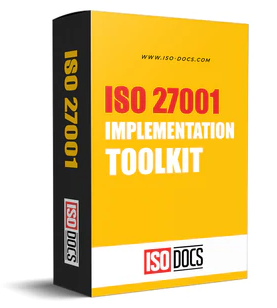Mapping ISO 27001 Toolkit Policies to ISO 27002 Controls
Introduction
Organizations should ensure that they adopt proper mapping of the ISO 27001 toolkit policies to the relevant ISO 27001 controls to ensure a smooth implementation process. Effective mapping of policies and procedures to controls is important for several reasons. It ensures adequate coverage, reduces duplication, and prepares an organization for audits and certification processes. This article explains how to align high-level ISO 27001 toolkit policies with actionable ISO 27002 controls. This process often entails reviewing Annex A, identifying related ISO 27002 controls, and cross-referencing policies.

Benefits Of Mapping
There are several benefits associated with mapping ISO 27001 Toolkit policies to ISO 27002 controls, including the following;
- Provides clear and comprehensive coverages ensuring no part is left unprotected.
- The process improves audit readiness by highlighting all implemented controls
- Reduces control overlap that may arise during the implementation process.
- Assists in highlighting gaps early allowing for their timely address
Mapping Methods
One of the critical aspects in the mapping process is selecting the mapping method you will follow as an organization. There are a variety of methods that can be adopted, including the following;
-
Policy-Level Mapping: With policy-level mapping, each ISO 27001 Annex A control area will be mapped to correspond to one or more supporting policies in the toolkit. For example, an ‘Information Security Policy’ template aligns with ISO 27002 section A.5 (Organizational controls), which covers issues related to do with governance, leadership commitment, and policy documentation. Another example would be an ‘Access Control Policy' that can be mapped to align with A.9 (Access Control A.8.2 in 2022) and includes aspects such as user provisioning, privilege management, and authentication. Policy-level mapping is often preferred because it ensures no control is left unaddressed.
-
Procedural and Operational Mapping: The basis of this mapping is that, as the ISO 27002 describes how controls should be implemented, the toolkit policies should also capture this detail and translate it into organization-specific procedures. For instance, because Annex Control A.8.9 Configuration Management requires baselines and change management, the toolkit should therefore include a Configuration Management Policy that outlines steps involved in configuration management, such as version control, change approval, and review. This type of mapping ensures that the organization's implementation processes closely reflect ISO 27002 guidance.
-
New 2022 Controls Mapping: This applies to the 11 controls that were introduced by the 2022 revision, such as Threat Intelligence (A.5.7), Cloud Services Security (A.5.23), ICT Readiness for Business Continuity (A.5.30), and Secure Coding (A.8.28). This means that the toolkit must now include or update policies to address these areas. For example, an organization’s Cloud Security Policy can be mapped to A.5.23, detailing vendor risk assessments, shared responsibility models, and contractual security clauses involved in cloud security practices.
-
Control Domain Mapping: This type of mapping involves grouping policies by control domains. It should be noted that ISO 27002 organizes controls into themes, namely Organizational, People, Physical, and Technological. It is therefore easier and user-friendly for any robust toolkit within an organization to mirror these domains. This also enhances traceability. For example;
-
Organizational: Information Security Policy, Risk Assessment Policy (A.5).
-
People: Acceptable Use Policy, Security Awareness and Training (A.6).
-
Physical: Physical Access Control Policy, Asset Handling Procedures (A.7).
-
Technological: Secure Development Policy, Logging and Monitoring Policy (A.8).
-
Organizational: Information Security Policy, Risk Assessment Policy (A.5).
-
Mapping to Other Standards and Regulations: The mapping exercise also helps align ISO 27001 policies to other requirements such as GDPR, HIPAA, or SOC 2. Since many ISOS 27002 controls such as access controls, encryption, and configuration management often overlap with these frameworks, a well-mapped toolkit supports multi-framework compliance and reduces unnecessary duplication.
Best Practices In ISO 27001 and 27002 Mappings
The following are some of the best practices organizations can adopt when mapping ISO 27001 toolkit policies to ISO 27002 controls.
-
Use of Tools: As the process is generally labour intensive and time-consuming it is advisable to use a tool to assist in the process. These tools can be automated or manual in the form of spreadsheets or Governance, Risk, and Compliance (GRC) tools respectively. This assists in maintaining traceability between policies and controls.
- Hire an expert: The mapping process is a technical area that requires appropriate technical skills is the process is to be effective. It therefore necessary to hire a professional such as a certified ISO 27001 Lead Implementer/Auditor to lead the process.
Conclusion
Mappings of ISO 27001 toolkits to ISO 27002 controls is critical in ISO 27001 implementation processes. When auditors review the design and operating effectiveness of an ISMS, they often want to see evidence that each ISO 27001 control has been addressed. A clear mapping document showing how each control has been implemented alongside the relevant toolkit policy or procedure helps an organization in demonstrating readiness and avoiding nay gaps. This is crucial in speeding up the implementing process while maintaining accuracy as well.


